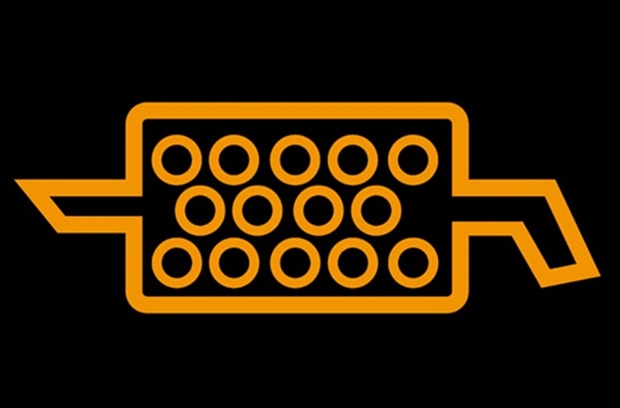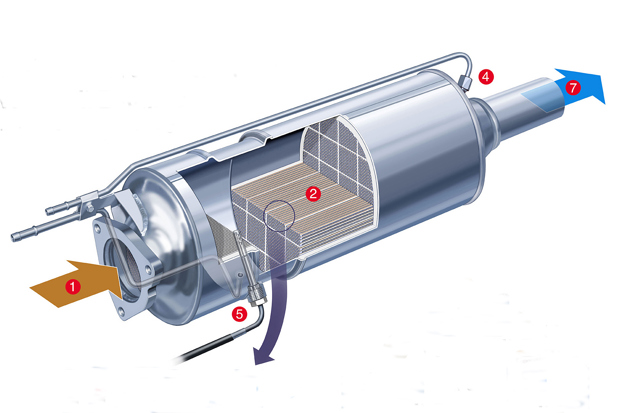Diesel Particulate Filters: DPFs explained
If you own a diesel car, chances are it's fitted with a Diesel Particulate Filter — DPF for short. They can be a source of problems but our guide will help you avoid them.

- How Diesel Particulate Filters work
- How to avoid DPF problems
- DPF cleaning cost
A Diesel Particulate Filter — known as a DPF for ease — is part of a diesel car's exhaust system, designed to filter out harmful particles. Unfortunately, not maintaining a DPF properly can lead to costly repairs or even a replacement unit.
Diesel engines produce a lot of soot when they burn fuel, which is known as particulate matter. It’s a very fine powdered substance that can cause serious health problems, particularly related to breathing.
The DPF's role is to filter-out and store this soot to reduce the amount that escapes from the exhaust. Because the soot storage capacity is quite small, DPFs go through a regeneration cycle where the particles are regularly burned off.
When a diesel-engined car is only used for short journeys, the DPF regeneration doesn't take place properly causing soot to block the filters and preventing the engine from running. At that stage you are likely to face a hefty cleaning bill for even fork-out a considerable amount more for a new DPF.
It's no surprise we receive so many questions from readers about DPFs.
Does my car have a DPF?
If it you drive a diesel-engined car sold new from September 2009 then it will be fitted with a DPF.
This was the date from which tougher Euro5 emissions regulations came into force which significantly reduced the amount of particulates diesel cars were able to emit — DPFs were essential in ensuring the law was complied with.
Be aware that several diesel models sold before this date also had DPFs fitted. You car's handbook should clarify whether or not yours has one.
How does a DPF work?
As we've already mention, DPFs filter, store and then burn-off the harmful soot released when diesel fuel is combusted in the engine.
That regeneration process where the excess particulate matter is burned off reduces the amount of harmful emissions — on older diesels that soot was often visible in the form of plumes of black exhaust smoke under acceleration.
Two types of regeneration are employed in this process — passive and active. In order to avoid DPF problems it's vital that diesel-engined cars are driven on sufficiently long enough journeys for the regeneration methods to take place.
Passive regeneration
This takes place while driving using the heat of the exhaust. Doing this on a regular basis is enough to burn off the soot and turn it to ash. However, it requires the temperatures created when a car is running at speed for a sustained period of time.
To make sure that the regeneration takes place, it's advised that diesels are driven for a good 30 minutes each week on roads where a constant speed of 60mph or more can be maintained.
However, passive generation isn't always possible, for instance if you regularly sit in stop-start urban traffic, leading to car manufacturers developing active regeneration.
Active regeneration
Here the exhuast gas temperature is artificially increased by injecting additional fuel into the system, causing it to burn more richly.
It still requires a journey of a reasonable length, though — around 10 minutes at 40mph or more is the suggested time.

How do I know if my DPF is regenerating?
When the DPF is regenerating you may notice the the cooling fans running and higher fuel consumption. The telltale sign for many is a hot and unusual smell from under the car.
Additionally, the engine's idling speed will typically be higher than usual and the car's start-stop system will be temporarily deactivated.
How do I know if my DPF is blocked?
DPFs get clogged with soot if regeneration doesn't happen often enough. If that's the case you'll see a DPF dash warning light pop up which looks like this:

This usually happens to drivers of older diesels that do lots of short trips, or lots of slow speed urban driving, because the vehicle doesn't get up to a high enough temperature to achieve passive regeneration. Cars with active regeneration should see fewer DPF problems.
How long can I drive with the DPF warning light on?
Not very long is the answer. When the DPF warning light appears on your dash, it's indicating that the filter is nearing its storage capacity and requires prompt attention.
Though your vehicle won't immediately stop once the light appears, prolonged driving without addressing the issue can result in significant problems such as poor fuel economy, decreased performance and in extreme cases, engine damage.
If you leave it, the car is likely to go into limp mode, restricting power and speed.
What happens if the DPF warning light is ignored?
If left any longer, the DPF won’t be able to regenerate itself and will need to be cleaned or even replaced.
You should also ensure you use the right engine oil. Certain oils contain additives that can actually block DPFs.
Using low-quality fuel and running the car frequently on a low fuel level can also harm a DPF because the car may avoid regeneration in order to save fuel.
Is it illegal to remove a DPF?
Yes. It is illegal to drive a car that was designed to have a DPF without one fitted. This is because should you remove it, your car no longer meets its emissions standards.
Owners face fines of up to £1000 for cars and £2500 for vans if caught. Removing a DPF can also invalidate your car insurance policy as well as any remaining warranty.
From February 2014, checking the presence of a DPF became part of the MoT test. All cars that are designed to have a DPF now get inspected for one. If it’s missing it will mean an immediate failure.
Where can I get my DPF cleaned?
If your DPF light comes on and driving it at speed doesn't solve the problem, it may need cleaning. There are plenty of places you can get this done without it breaking the bank.
Here are the companies to look at if you need your DPF cleaned:
| Product |
Price |
Details |
|
Deep DPF Clean |
£199 |
Mobile service at no extra charge |
| Product |
Price |
Details |
|
DPF Clean |
£279 |
Includes a diagnostics check |
| Product |
Price |
Details |
|
DPF Maintenance Treatment |
£35 |
Designed to be used every six months |
|
£50 |
For drivers regularly undertaking short journeys |
|
|
DPF Flush |
£85 |
For heavy soot build up |
| Product |
Price |
Details |
|
Preventative Maintenance Service |
£110 |
Cars with engines up to 1999cc |
|
£130 |
Cars with engines of 2000cc or more |
| Product |
Price |
Details |
|
DPF Clean |
£265 |
Diagnostics charged at £90 an hour |
How much does a replacement DPF cost?
If you don't maintain the DPF properly, excess soot can damage the DPF beyond repair. If this is the case, it has to be replaced — and they're very expensive.
A new DPF can cost anywhere between £1000 to £3500. There are DPF suppliers that charge less, but make sure they have the correct Type Approval or they may not work properly and end up costing you more in repairs.
How long should a DPF last?
A DPF can last around 100,000 miles if maintained properly. After the car has exceeded that mileage, you could be looking at paying a large amount of money for a replacement — so always properly check MoT and service records when buying a used car or run the risk of forking-out for unexpected repairs on high-mileage diesels.
Is a DPF covered under warranty?
Most manufacturers' warranties won't cover the cost of DPF replacement if the fault is deemed to have been caused by the owner's 'driving style'. Given that a replacement DPF costs upwards of £1000 it's not hard to see why manufacturers aren't keen to cover them.
There are many factors influencing the lifespan of a DPF besides the driving style of the car's owner, such as the annual mileage, the journeys most frequently undertaken and the engine oil used.
We are yet to hear from a reader who has been successful in getting a failed DPF replaced under warranty.



